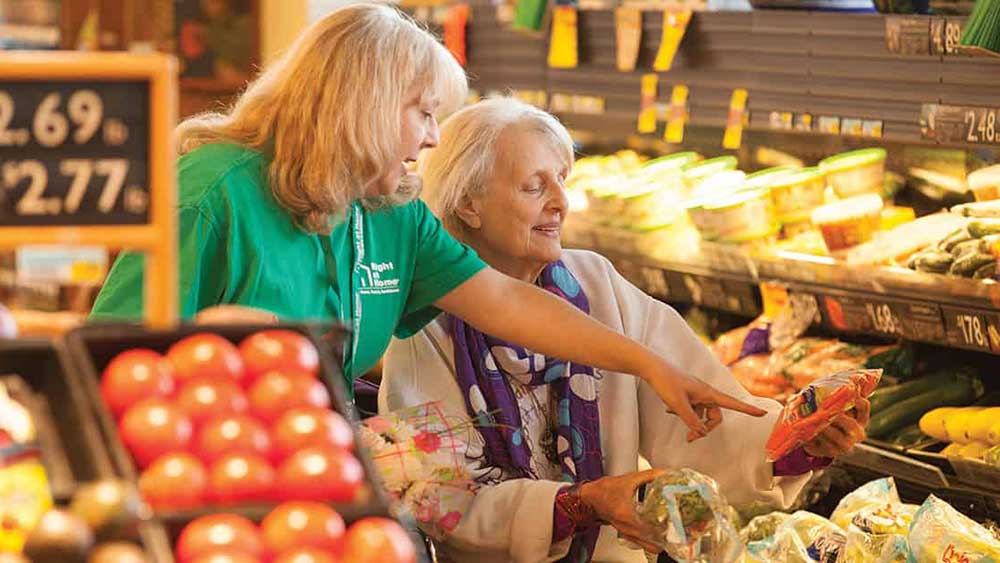

10 Ways to Help a Senior Loved One Manage Diabetes
10 Ways to Help a Senior Loved One Manage Diabetes
It’s a startling statistic for seniors: More than 25% of people over the age of 65 have diabetes, according to the Centers for Disease Control and Prevention (CDC). Age is a top risk factor for Type 2 diabetes, the most common form of the disease.
The complications of diabetes can be severe. Diabetes increases the risk of infection. It can damage the heart, kidneys, nerves and eyes. It raises the risk of dementia, incontinence and falls. It reduces both the quality and length of life.
Fortunately, diabetes can be managed. Some seniors can keep their blood sugar at a safe level with lifestyle changes, such as improved diet, increased exercise, quitting smoking and maintaining a healthy weight. The doctor may prescribe medications, in the form of pills, injections or an insulin pump. People with diabetes must monitor their blood sugar and see their doctor regularly.
To complicate matters, senior patients are often dealing with multiple health conditions. The National Diabetes Education Program says that the support of family is vital for helping them cope with day-to-day diabetes care. While family often lend a hand, it can sometimes feel like a full-time job! As the population ages, more family members will find themselves in this helping role, so this is a good time to review these 10 tips:
1. Help your loved one make and keep appointments with their healthcare team. Diabetes management can require a lot of back and forth between the patient and their various providers, which might include their primary care physician, endocrinologist, ophthalmologist, podiatrist and other specialists as needed. Then there are trips to the pharmacy, to exercise class, or perhaps to a smoking cessation support group. Effects of diabetes, such as nerve problems and vision loss, can make it unsafe or impossible for your loved one to drive. If you can’t do all the chauffeur duty, help your loved one access alternative transportation, such as public transit, senior transportation, or ride-hailing services. Right at Home caregivers also provide transportation and help clients keep track of appointments.
2. Go along to appointments. It’s vital that your loved one follows the doctor’s recommendations for taking medications, as well as measuring and recording blood sugar. But they may feel flooded and overwhelmed by all the information. Moral support and an extra set of ears can help. Today, healthcare providers are recognizing the important role family and others play in helping people manage their diabetes. Take notes and help your loved one prepare questions ahead of time. Professional Right at Home caregivers can also be a great support resource, accompanying your loved one to appointments and sharing information with you.
3. Learn all you can about your loved one’s condition. Check out reputable online information from sources such as the National Institute of Diabetes and Digestive and Kidney Diseases, the American Diabetes Association, and the Right at Home website. The best source of information is your loved one’s doctor. Ask any questions you have, such as the signs of low blood sugar and what you should do if that happens.
4. Assist with medication management. Your loved one might take pills to control their blood sugar. If that isn’t enough, they may have insulin injections with a syringe or pen, or use an insulin pump. Talk to the doctor about ways you can help. Assist your loved one in keeping track of which medications to take, and when, and how. Look into ways pill boxes, a chart or alarms can help them keep everything organized and timely. Voice assistants also can help. The doctor or pharmacist also should review all the medications your loved one takes, for all health conditions, at least once each year.
5. Get creative in the kitchen. One of the most important ways to control blood sugar is through diet. Your loved one’s doctor will most likely recommend an eating plan that includes fewer sugars and carbohydrates, which are found in pasta, potatoes, rice, tortillas and desserts. Instead, people with diabetes should eat more veggies and proteins. Portion size and timing of meals also matter. But changing the eating patterns of a lifetime can be distressing! Help your loved one give their fridge and pantry a makeover, and adapt recipes to be healthier.
6. Be your loved one’s cheerleader for increasing activity. Along with healthy eating, exercise is a top way to control blood sugar. Your loved one’s doctor can prescribe an appropriate exercise program, which will include aerobic and muscle-building activities. This could be an exercise class or a home workout. If your loved one can’t safely walk, ask the doctor about seated exercises, a chair exercise class, or a water fitness program. You can help! And by going for a stroll with your loved one instead of visiting on the couch, you’re adding some extra movement to your own day, too!
7. Help your loved one inspect their feet. People with nerve damage caused by diabetes might not notice blisters, calluses or injuries to the feet until serious infection has set in. This could even lead to amputations. Regular inspection can catch problems early, but can be difficult if your loved one has poor vision and flexibility. Report cuts, blisters, swelling or redness to the doctor right away. Help your loved one keep their feet clean and dry, and keep nails trimmed. Urge your loved one to choose well-fitted shoes and slippers, and to wear them even around the house — going barefoot raises the risk of foot injury.
8. Avoid power struggles. You arrive at your father’s house only to find candy wrappers on the coffee table. “Dad, should you be eating that?” you say. You just want Dad to be healthy, but he tells you to mind your own business. This, of course, is a great example of the age-old safety vs. independence struggle between seniors and those who love them! Reassure your loved one that by helping them preserve their health, you’re also protecting their independence. Keep your sense of humor if you can.
9. Make your loved one’s condition a family affair. Because it is. If one relative has diabetes, others have a greater genetic risk of developing the condition. Lifestyle choices, too, can run in families. Make eating well and exercising a regular thing in your home. That way you can say, “Mom, I made this healthy meal for you, but it’s great for my health, too!” Healthy lifestyle changes can be contagious, serving as teachable moments for the younger generation, as well.
10. Get help from professionals. The time may come when you can’t do it all alone. You have a job, kids, other obligations — and maybe you live hours away from your loved one. Studies show many caregivers put their own health at risk as they try to manage all these jobs at once.
Home Care Can Help
Sometimes moving to an assisted living or other supported living community is the best choice for seniors who are dealing with complex health challenges. If your loved one prefers to stay in their own home, or if they live with you, professional in-home care can be a tremendous support resource. Right at Home’s professionally trained in-home caregivers provide many services for clients with diabetes, including:
- Education about diabetes management and help managing health appointments and activities.
- Nutritional support, including meal planning and preparation, and grocery shopping.
- Supervision and encouragement as your loved one follows the doctor’s exercise “prescription.”
- Companionship to lift your loved one’s spirits and ward off depression, which is so common among seniors with diabetes.
- Respite care and an extra pair of hands to lower caregiver stress.
- Transportation to medical appointments, exercise classes — wherever your loved one needs and wants to go.
- Housekeeping and personal care to keep your loved one safe and comfortable at home.
To learn more about how Right at Home can help, find a local Right at Home office and download the free Adult Caregiving Guide.
The information in this blog is not intended to replace your doctor’s advice. People with diabetes should talk to their healthcare providers about managing their condition and complications.




